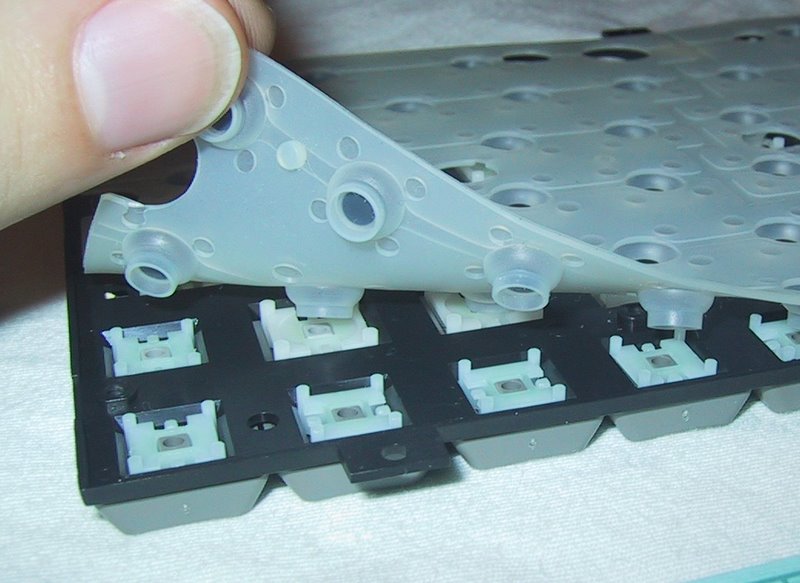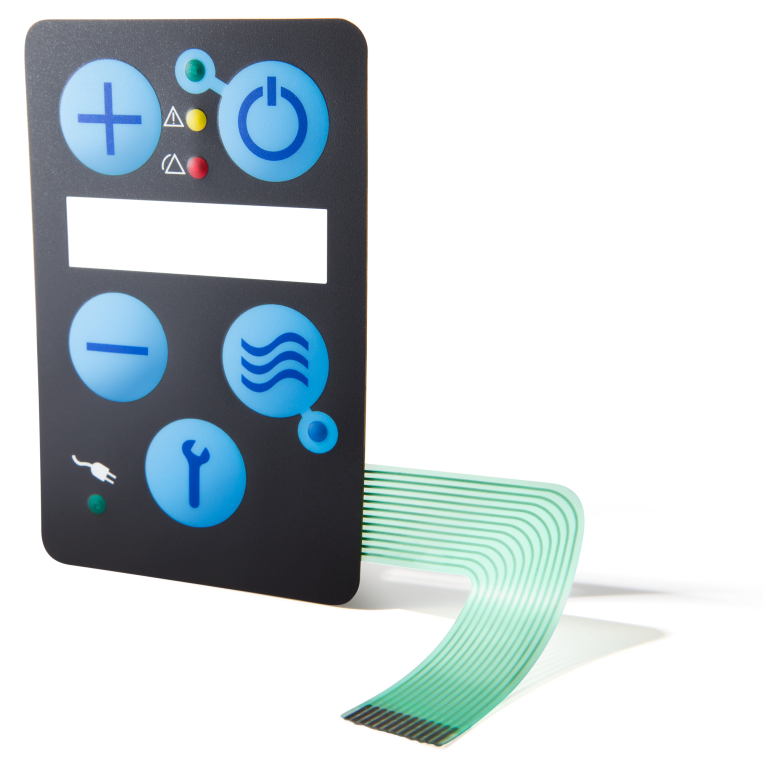Your Go-To Membrane Switch Manufacturer for Industrial Applications
Your Go-To Membrane Switch Manufacturer for Industrial Applications
Blog Article
Comprehending the Value of Membrane Switch in Modern Electronic Devices and Their Applications
Membrane changes work as a necessary element in modern-day electronics, offering an effective interface for individual communication. Their lightweight and personalized nature makes them appropriate for a variety of applications across varied industries. Comprehending their key elements and benefits can offer understandings right into their growing importance. As technology continues to breakthrough, the development of Membrane switches raises inquiries about their future applications and style technologies. What exists ahead in this vibrant area?

What Are Membrane Buttons?
Membrane switches are important parts in modern-day electronics, serving as interface that assist in interaction in between devices and customers. These switches contain a number of layers, including a visuals overlay, a sticky layer, and a circuit layer, every one of which interact to develop a practical and resilient user interface. The style permits a level, low-profile solution that can be personalized regarding size, shape, and visual look, making them appropriate for numerous applications, from consumer electronic devices to medical tools. The tactile feedback supplied by Membrane changes boosts user experience, while their resistance to dirt and moisture makes them optimal for challenging atmospheres. Furthermore, Membrane buttons can incorporate functions such as backlighting and published graphics, even more increasing their usability. Their flexibility and toughness make them a recommended selection in sectors where dependability and ease of use are extremely important, inevitably adding to the smooth operation of modern-day electronic gadgets.
Trick Components of Membrane Changes
While different parts add to the capability of a membrane switch, three main layers play considerable duties in its layout and procedure. The leading layer, generally made from a resilient polymer, acts as the user interface for customer communication, usually featuring printed graphics and symbols. Under this is the spacer layer, which keeps the required distance between the top layer and the circuit layer. This spacer layer assurances that the button turns on just when pushed, stopping unintended inputs. Ultimately, the circuit layer has conductive traces that finish the electrical circuit when the top layer is depressed. These traces can be made from various products, including copper or silver. Together, these components create a trusted and durable gadget that is portable and functional, appropriate for a variety of digital applications, from family home appliances to medical tools. Comprehending these essential components is essential for valuing the general functionality of Membrane buttons.
Advantages of Making Use Of Membrane Changes

Membrane Switch Manufacturing Refine
Comprehending the Membrane switch manufacturing procedure discloses the intricate actions associated with creating these important parts. The process typically starts with the design phase, where layouts and specs are developed using specialized software program. Following this, the graphic overlay is published on a versatile substratum, commonly using high-resolution printing methods to guarantee clearness and precision.Next, the glue layers are applied, which offer to bond the various parts with each other. The circuit layers, made from conductive inks or products, are then printed onto a different substrate. These layers are meticulously lined up and laminated flooring to create a practical switch.After setting up, the switches undertake checking to verify performance and durability. Quality control actions are executed throughout the procedure to identify and correct any type of issues. Finally, the completed Membrane buttons are packaged and prepared for distribution, ready to satisfy the needs of modern electronic applications.
Applications of Membrane Switches Over in Numerous Industries
Membrane buttons are increasingly utilized across various industries, especially in medical devices and consumer electronics. In the clinical field, they supply reputable control user interfaces for devices that need accurate operation. In customer electronic devices, these buttons improve individual interaction by using smooth and responsive interfaces.
Medical Tools Control
Countless modern-day clinical devices utilize Membrane buttons for structured operation this post and enhanced customer communication. These switches offer a trusted, resilient user interface for a range of applications, including diagnostic tools, individual monitoring systems, and surgical tools. Their customizable layouts permit details layouts that can accommodate the unique needs of health care experts, making certain instinctive navigation and efficient accessibility to important functions. In addition, Membrane buttons are resistant to pollutants, making them suitable for sterile atmospheres. The tactile responses they use can boost customer confidence, minimizing the risk of errors during essential medical procedures. On the whole, the combination of Membrane switches in medical equipment substantially contributes to boosted operational performance and client safety and security in healthcare settings.
Consumer Electronics Interfaces
In the domain of consumer electronic devices, Membrane switches play an essential function in enhancing individual interfaces throughout a variety of tools. These switches are important to items such as remotes, microwaves, and video gaming consoles, giving a effective and straightforward user interface. Their layout allows for a seamless combination of graphics and capability, allowing suppliers to create smooth, contemporary visual appeals without jeopardizing functionality. Membrane buttons are additionally understood for their durability, frequently standing up to considerable usage and direct exposure to numerous ecological problems. Additionally, they can include features like backlighting and tactile feedback, more boosting the customer experience. As customer needs for innovative yet user-friendly interfaces grow, Membrane switches remain to be a necessary element beforehand electronic tool capability.
Layout Factors To Consider for Membrane Switches Over
Creating efficient Membrane changes needs cautious attention to various variables that affect both capability and individual experience. One important consideration is the option of materials, as they can influence durability, responsive responses, and aesthetic appeal. Picking an ideal adhesive is crucial for assuring long-lasting adhesion and resistance to ecological factors.In enhancement, the design and design click this of the button should accommodate customer interaction, with button dimensions and spacing enhanced for ease of usage. The consolidation of graphics and labeling ought to focus on clearness and visibility under numerous lighting conditions.Consideration of electrical qualities, such as actuation force and switch level of sensitivity, will certainly enhance the responsiveness of the Membrane button. The style ought to fit making processes to ensure cost-effectiveness and prompt production. Overall, a well-balanced design improves both the customer and the capability experience of Membrane switches in modern-day electronics.

Future Fads in Membrane Switch Technology
As innovation remains to develop, Membrane buttons are positioned to integrate brand-new advancements that will enhance their performance and application in various areas. One significant trend is the unification of long lasting and flexible products, which will raise the lifespan and integrity of these buttons. Boosted surface appearances and customizable anonymous graphics are additionally expected, enabling even more intuitive customer interfaces.Moreover, the assimilation of clever modern technology, such as touch-sensitive surfaces and haptic comments, is anticipated to improve user interaction, making Membrane switches over extra receptive and interesting. In addition, developments in published electronics will certainly allow more complicated wiring within thinner profiles, additionally expanding style possibilities.Sustainability will certainly also play a vital function in future growths, as producers explore environment-friendly materials and production processes. In general, these fads will ensure that Membrane switches continue to be pertinent and vital in an interconnected and increasingly digital world.
Frequently Asked Questions
How Do Membrane Switches Over Compare to Conventional Mechanical Buttons?
Membrane switches deal benefits over conventional mechanical switches, including decreased dimension, lighter weight, and improved longevity. They typically supply a sealed surface, boosting resistance to dirt and wetness, making them ideal for diverse applications.
What Materials Are Commonly Used in Membrane Switch Building?

Can Membrane Switches Withstand Extreme Environmental Conditions?
Membrane switches can stand up to severe environmental problems, relying on their layout and products. High-grade building and constructions frequently feature toughness against temperature level fluctuations, humidity, and direct exposure to chemicals, making them appropriate for different requiring applications across markets.
The Length Of Time Do Membrane Switches Typically Last Before Failure?
Membrane switches over generally show a lifespan ranging from 1 to 10 million actuations, depending upon elements such as use regularity, environmental problems, and producing quality. Regular maintenance can prolong their longevity and operational integrity substantially.
Are Membrane Changes Customizable for Details Applications?
Membrane switches are certainly customizable for details applications. They can be customized in performance, design, and size, allowing makers to meet unique customer demands and boost product visual appeals while preserving operational efficiency and toughness. Membrane switches are necessary parts in modern-day electronic devices, offering as individual interfaces that help with interaction between customers and gadgets. The tactile comments provided by Membrane changes enhances individual experience, while their resistance to dirt and wetness makes them excellent for testing environments. The consolidation of graphics and labeling should focus on clarity and exposure under various illumination conditions.Consideration of electrical qualities, such as actuation force and switch sensitivity, will improve the responsiveness of the Membrane button. Enhanced surface area structures and personalized graphics are additionally anticipated, allowing for more intuitive user interfaces.Moreover, the combination of clever innovation, such as touch-sensitive surface areas and haptic responses, is expected to boost customer interaction, making Membrane changes a lot more receptive and appealing. Membrane changes offer advantages over standard mechanical buttons, including lowered dimension, lighter weight, and enhanced durability.
Report this page